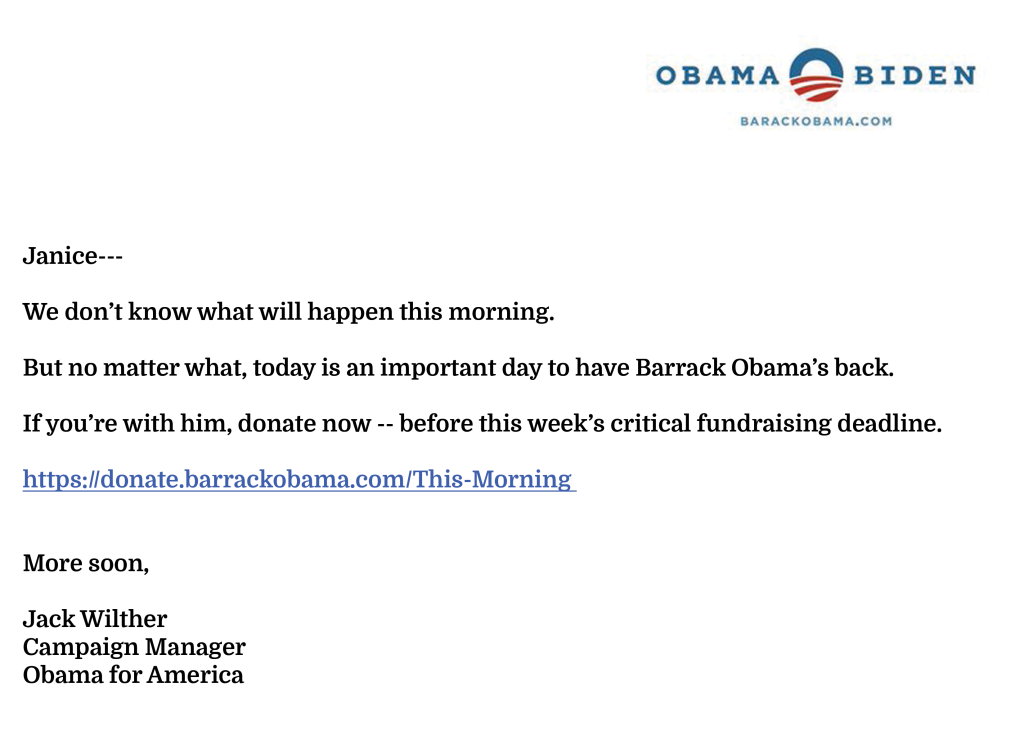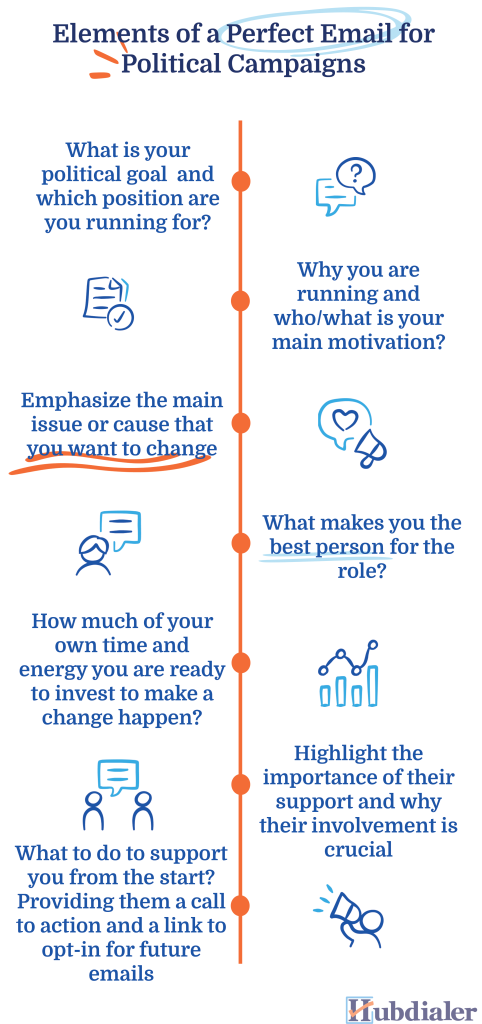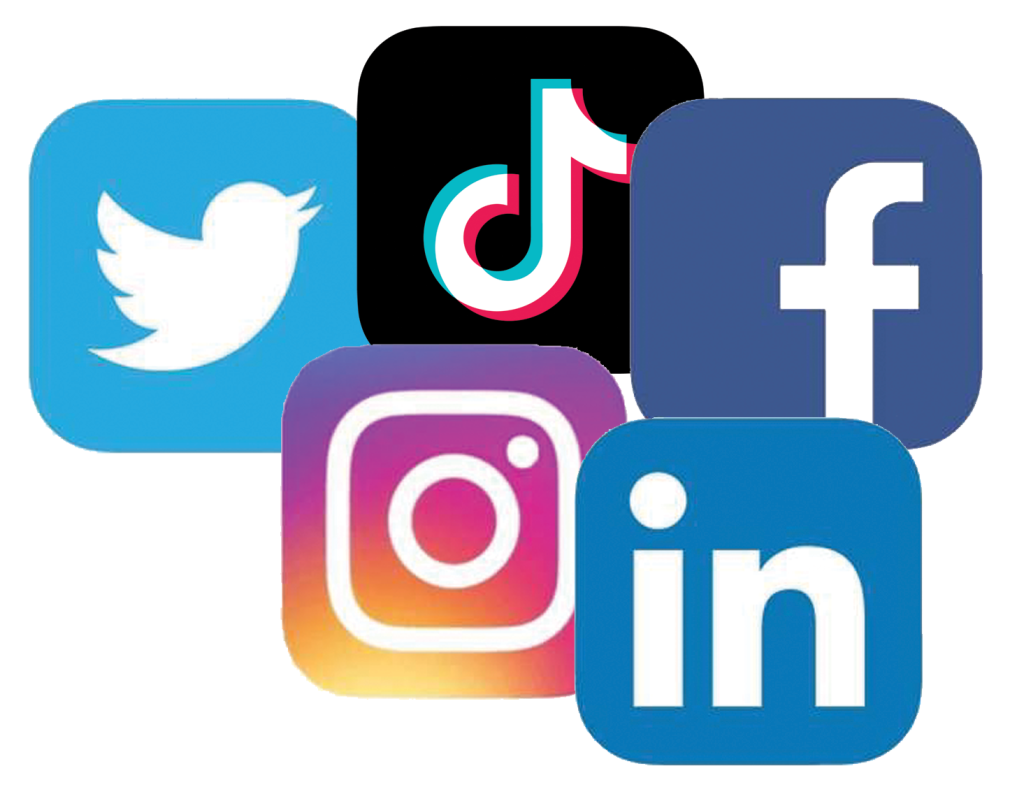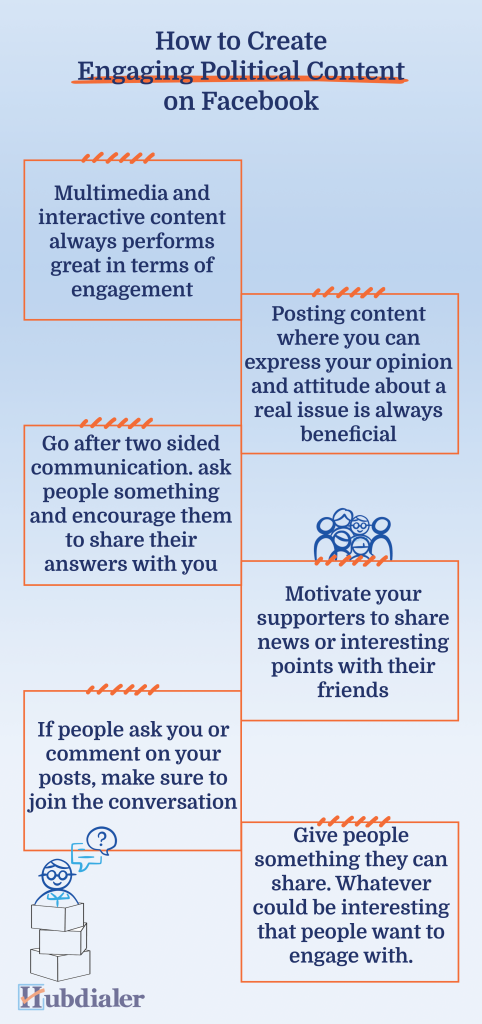Guides

By clicking "Accept All Cookies", you direct Hubdialer to store cookies on your device and disclose information in accordance with our Privacy Policy.
Texting is now live! Learn more
Guides


GUIDE TO HUBDIALER

TABLE OF CONTENTS
A well-crafted and information-rich website is the basis for any campaign or organizational activity. While you might store lots of valuable content on it, most people won’t find that content unless you share it.
Planning and executing thoughtful email campaigns is important for many reasons. For starters, you own the medium and control who gets which messages.
This guide will show why and how email, social media, and digital advertising work for political campaigns. These channels play a huge role in voter outreach, mobilization, persuasion, and winning the elections.
For your email channel to bring results, people must sign up for your email campaigns and opt-in to receive them. Some people will want to get in touch with you and hear more about your campaign, while many will not want to be spammed and included in the conversations you run.
Most political email campaigns start with a large database of contacts you build manually. You want as many people as possible to join your list, but only if they want to receive your messages. Spamming people won’t get you anywhere, and you won’t build a digital audience that trusts you.

Once the initial number of people agree to be on your mailing list, you will want to keep growing from there. Every campaign activity, event, and action is a chance to ask people for their emails and include them in your newsletters. However, your job is to ensure people read and engage with your messages.
When writing emails for a campaign, you should keep things informal and action-oriented. The best-performing email messages ask people to do only one thing. Asking people for something early in your mail and repeating the request one more time will help readers stay engaged and click on the link that (most often) you share with them.
When it comes to emailing frequency, there is no right or wrong answer. You can send emails every few days if you have much information and news to share. If the unsubscribe rate is low, you can keep up the tempo, but if you notice that many people are leaving your email list, you might need to send your emails less frequently. Monitor the data from your email provider to find the sweet spot.
Do you need an email platform? In short, yes. Your campaign list will consist of people with different interests and goals, and you will often need to segment the subscribers according to some criteria. Email platforms allow you to personalize messages and easily include legal requirements such as disclaimers and unsubscribe options.
Your email program will need a marketing platform to distribute the messages to your desired contacts.
Popular tools for general email campaigns include Mailchimp, GetResponse, and ConvertKit, while tools like NGP VAN are specialized for digital political campaigning
The main purpose of the content you will share via email messages is to grab and keep your audience’s attention. To achieve that, you must offer effective content to that audience.
What makes email content effective? A couple of things:
Assuming that you went through the basics of using email for campaigns and had most of the technical things in place, you will likely start focusing on writing an actual email that helps your campaign.
With that in mind, here are the recommended steps when working on any campaign email.
Let’s look at the most important email elements.
Your campaign will require you to create dozens of different email types sent during different campaign phases. Let’s assume that you want to kick off your campaign and send your potential supporters and voters a very first email.
For a start, you should have a rough outline of the main content of your email. Your potential voters should know the following:

The whole message shouldn’t take too much text – a couple of well-crafted and to-the-point paragraphs will do the job. Make sure to write a first draft using something like Google docs or a Word document and insert your links for now. Later you will focus more on fixing mistakes and editing.
When the first draft of your message is ready, you need to refine it and make sure other people perceive it as you do. Asking for feedback and opinion from people that represent your target audience is a good way to hear if you are on the right track.
Use this phase to check the grammar, remove unnecessary parts, and format the content to emphasize key action points and messages..
A great thing about using email platforms is that they offer dozens of different email templates that you can use for your messages. You can find and customize a template that makes the most sense for your campaign.
You can also create your template and add campaign logos, colors, visual elements, typography, etc. We suggest getting this right since you will want to be consistent and use the same template for the future emails you will send.
If you are happy with the content of your message and your template, you can add that content to the email software.
This is where you can choose which people you will email – your entire database, only a part of it, existing contacts, or only those recently added, etc. Also, consider the potential personalization elements we mentioned before and add them in the subject line, opening parts and checking that everything works with your call to action.
If some parts seem too technical at the moment – don’t worry. All email platforms come with instructions that are easy to follow, even for people new to this.
Before you send your email to your subscribers, test if everything works – links, graphics, loading, contact list, etc. The best way is to only send a test email to yourself and check if everything looks good in your inbox.
If you need to email immediately, hit the “Send” button. Or, you can schedule your email for later. A good tactic is to work on a series of emails in advance and have everything ready before the time comes. As you may know, things get pretty hectic during the campaign, and it helps a lot if you have your message already written and scheduled.
How often you send emails depends completely on your campaign – some people send them every few days, while some do it once weekly, which is also fine.
Also, not everyone in your database will need to receive every email you send. People have different interests and should receive only messages that are relevant to them.
There needs to be a clear rule on how you will segment your subscribers. Still, consider your audience demographics, location, previous interactions with your website, donor history, etc.
For example, someone who is 28, lives in a big city, and has donated to your party before is completely different from a 53-year-old person from a rural part of the country that has never donated to similar activities.
The clearer your picture of your email subscribers, the easier it will be to segment them and craft actionable messages that move them.
Social media has changed the way the world communicates. While it didn’t revolutionize the world of political campaigns, social media is another powerful tactic that political staff can use to reach out to potential voters and communicate with their followers.
More than 300 million social media users are in the US, meaning most voters are already there. So not only is social media a powerful channel to reach the voters, but it is also a channel that current political officers use to communicate more effectively with their constituents.
So how and why can social media work for your campaign?
If you are new to social media, you might not know which platforms you should use for political purposes. Even if you have personal experience with multiple platforms, that doesn’t mean that every platform is equally important.

Here is a quick overview of your potential to win with different platforms.
Facebook is the most popular and best type of platform for political campaigns. Because social posting takes time and effort, if you want to do it right, you want to focus on the right platforms. And if there is only one platform that you can choose for your political race, we suggest going with Facebook.
Nevertheless, if your candidate has a strong social presence on other channels and your campaign invests in paid social ads, you must also consider other social platforms.
Twitter can be a great platform for political campaigns, but it works differently than Facebook.
Use Twitter if you do a lot of press coverage and communicate with journalists since new media is very active on Twitter. Also, if you post multiple times daily, cover a range of trending topics using hashtags, and follow/reply to reporters, Twitter can work well for you.
Instagram is a platform that targets mostly younger voters and is great if you want to share stories about your campaign visually.
If you have a very active campaign with many photos and videos being created, Instagram can help you share them easily with your followers.
Remember that even though something seems trendy, that doesn’t mean you have to use it in your campaign. Being active on social media takes time, and you shouldn’t do social posts just for the sake of them. Focusing on the right platform and sharing your content properly is better.
The content you post on social media needs to be engaging. Social media users have a short attention span, meaning most people skim the content and don’t even look at it if it is not interesting.
If you want to get your voters’ attention, your content must be more engaging than other posts, which is challenging to achieve.
Your posts need to tell the people how your program makes a difference and how it will make an impact and invite them to take some action. It can be a request for donations, inviting volunteers for a specific task, or any event that matters.
At the very least, you want to mix different things in your posts. If you need to ask people to do something, be specific about what you need from them and why. If you know your audience, you must adapt your tone and language style to them.
Listen to what people say and try out different posts. Monitor what types of posts perform the best and add more of those to your future posts.
And if you combine these simple tips with authenticity, listening, and offering people at least a bit of a better world, your voters will reward you.
While there isn’t a strict rule about the type of content you can publish on each social network, some things work better on certain social channels.
For instance, video content can be uploaded and shared directly on Facebook without linking to YouTube. Twitter works great if you plan to communicate with news media and share the content that your supporters create for you.
And as mentioned before, Instagram is great when you want to create a story from a bunch of photos you own. Visuals and photos help potential voters see how a candidate operates during a campaign, and people can connect more easily to those situations.
Whatever you decide, make sure to check the analytics that each social channel provides regularly. If something works and brings viewers, engagement, and followers, you want to stick with that. Find content that works best for each platform.
How you use Facebook matters to your campaign as well. Not all your campaign posts will be seen by your followers; the algorithm doesn’t work that way.
However, if you understand how the algorithm works, you can work on your post in a way that helps the algorithm push your posts more. There are a couple of important things to keep in mind when designing content for Facebook:
There is no hard rule about when and how often you want to share political content on Facebook, but a general rule of thumb is to post at least once daily during the regular campaign period.
Once your campaign gets to the final phase and you work on GOTV (get out the vote) phase, you will want to post multiple times daily, fight for every supporter, and push your voter turnout.
There is plenty of great advice for people who want to use Facebook for different goals. Still, in the context of political campaigns, we suggest focusing on a couple of crucial elements you can implement with your posts.

The first thing you need to do is create a Facebook page for your campaign. There are many instructions and tutorials on how to do this, so that we won’t discuss that. Just make sure you choose “Community or Public Figure” as a page type and “Political Candidate” as a category for your page.
Before you start posting like crazy, take a moment to think about the key assets you will need for your page and how you will manage them.
Facebook is a great channel for your campaigns. It can help you grow your voter base, share information with them and get people to do specific actions. In short, all the things that you need to win a campaign.
The final chapter in this guide to digital campaigning tactics will focus on paid channels and advertising. Until now, we covered the set of tactics that weren’t focused on buying ads to reach voters.
Campaign officers must plan how paid ads will contribute to total campaign efforts. This includes understanding
Answering these questions helps campaign managers prepare the right digital ad strategy, assign budgets and monitor progress toward the vote goal.
It is important to note that digital ads can’t replace other digital and traditional tactics. Paid ads work great when they need to support existing activities, but they should never be used as the only tactic, even if your campaign has a big budget.
Like other channels we talked about in this guide, the starting point for creating effective ads is the audience. There is no point in buying ad space on networks where your target audience is not present. Your ads need to target the right people at the right time.
Furthermore, not all ads can be created easily. Some networks may have complicated ad settings, or how exactly people use that channel might need to be clarified. The campaign staff has to feel comfortable and familiar with the targeted platform. Otherwise, the effect might be off target, and the budget and time might be wasted.
When starting with digital ads, you need to set clear goals. Will you work on creating campaign awareness, recruiting volunteers, or simply enhancing your voter outreach efforts?
Let’s look at some of the typical goals you will try to achieve with paid ads.
If you want people to vote for you, they must know who you are and what messages you communicate.
Working on campaign awareness should be the first step of any campaign. Building awareness will help turn people into donors, supporters, and voters. Most of the time, you want to focus your ads on one outcome, so be careful if you are trying to communicate too many things simultaneously, such as pushing awareness and asking people to do some action.
Turning undecided voters into supporters is a big goal of any campaign. However, it is only sometimes simple to measure how effective ads are in persuading people. While we want people to see and perceive the ad properly, we also have to be aware that many people won’t be persuaded just by seeing an ad.
The best way to work on persuasion ads is to narrow down the targeting and ensure that a certain ad appears frequently enough so it can influence the target audience. Calculating the audience reach and ad frequency is also important for getting the ad costs right.
This goal is the easiest one to measure. We launch an ad that asks people to do something, so if we succeed, the people respond positively, and we get immediate results from it.
Typical response actions include donations, sign-ups, and any specific action that can be tracked at any time.
Digital ads allow us to target potential votes far more effectively than traditional media. We can target people by demographics, location, and interest and even target potential voters using data from their previous platform activity.
The key point to remember is – digital ads work, and they help campaigns reach different audiences, raise money, persuade voters, get people to vote, and win elections.
Just like political activity is manifested through political campaigns, digital ads also work on a campaign level. In a nutshell, ad campaigns refer to advertisements that aim to achieve a specific goal. These goals typically include one message and can be achieved across different platforms during a specific time.
Digital ads come with a bunch of metrics that you digital marketers measure, but the most relevant metrics are the same ones you would use for political marketing, such as:
As someone working on political campaigns, you may not be an expert in ads. However, your co-workers or volunteers might help you set, run, and report on ads. You want to ensure you understand basic metrics and ask the ad person to show you how the numbers are moving and if the ads are effective considering your investments.
Once you decide to invest your campaign budget in paid ads and work on achieving your campaign goals, you should consider the platforms you will use. Naturally, based on your audience targeting, you want to push your ads on the platforms where you have the highest chance of reaching that audience.
Some popular platforms you can use are Meta platforms, Google network, and video ads.
Meta platforms consist of Facebook and Instagram. As we mentioned before, Facebook offers many opportunities for political marketing both on a free side and for paid ads. With so many people using Facebook, you should use it to cover your main demographics and work on building campaign awareness and persuading people to vote for you.
Most successful content on Facebook is images and videos, so you must prepare your visuals properly for each paid campaign.
Instagram is less popular than Facebook for political ads. However, it is great for targeting the younger population. Also, both platforms come with their analytics, so if you run paid ads; you will get a solid overview of what kind of people watched your videos.
Google ads network is the next big platform that you can use to advertise your campaign. It consists of Google Display and Google Search ads.
Google Display ads most often consist of images on websites and social media platforms. Display ads make the most sense when you want to expose your campaign messages to many people and increase awareness.
A good tactic is to use display ads to push your campaign presence on local news sites with targeted ads relevant to a specific region. A downside of display ads is that they show everywhere without considering the user’s search intent.
This problem is solved with Google Search ads, which are text ads that appear in Google after users type in specific keywords. Because search ads can be connected and target specific user intents, this makes them a good option when you want to push specific actions or direct user response, such as volunteer recruitment, donations collection, or even providing voting information.
YouTube ads are another good option that you can use for spreading campaign messages. If you have a short campaign video that you want to show to your audience, YouTube can show it to people before they start watching their videos.
By covering these big platforms, you can reach many of your users. If you want more options, you can show your ads to people using digital streaming radio or other video platforms, but we suggest sticking to the main platforms.
Building a digital presence online and pushing a political agenda is a process that takes careful planning and execution, but it is worth your time and resources.
Start by understanding how digital channels can help you reach your political goals – who your audience is, what they do, what kind of messages you want to share with them, and how this will affect your goals.
After that, create a campaign website that will be your main hub and central location with all activities, a campaign calendar, and a source of information for your political program.
Once you strategically create a website that contains important information for your current and future supporters, you should start investing in the mediums that will allow you to connect with your voters.
Use email to communicate regularly with people interested in your campaign and include them in your most important campaign activities. And use social media to keep the general audience informed and understand your program’s main values.
Finally, reserve some budget for digital ads to ensure your messages reach the right voters at the right time.
With a mix of channels that help you work on digital campaigning, you can work on all sorts of political goals and ensure the effectiveness of the campaign efforts.